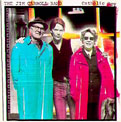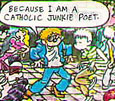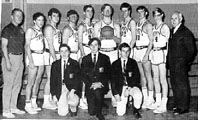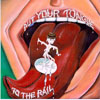|
Support CatholicBoy.com! |

About Jim CarrollUpdated 14 February 2009Lynn Hirschberg, describing a Jim Carroll Band concert in 1980, before the release of Catholic Boy, reported overhearing a Oui photographer remark, "You're watching the Dylan of the 80s, you know. . . . Seeing Jim Carroll now . . . is like witnessing history."
Indeed, Jim Carroll expressed the Bomb-fear anticipation, the optimistic nihilism and glittering darkness of the 1980s that we who were there felt even if we couldn't communicate it ourselves. When John Lennon was assassinated in front of the Dakota in December 1980, "People Who Died" was one of the most-requested songs on FM radio, just after Lennon's own "Imagine." Steven Spielberg chose "People Who Died" to play during the opening scene of E.T. The Extra-Terrestrial. "People Who Died" tapped a mainline. It was a hit even before it was released, and, as Newsweek's Barbara Graustark noted, it "propelled [Carroll] from underground status . . . to national attention as a contender for the title of rock's new poet laureate."
"People Who Died" wasn't the only thing that sustained Carroll's reputation. The first full-length article about him appeared in 1969, when Jim was 19, and he was featured in Rolling Stone as early as 1973--the same year, it was rumored, that he was nominated for a Pulitzer Prize at age 22. The 1980 release of Catholic Boy, along with the re-publication of his cult- classic book The Basketball Diaries, shot Jim and his band into the international spotlight. Catholic Boy, named the second-most-popular album of 1980 by BAM, is now considered one of the last great punk albums. Jim appeared with his band on the variety program Fridays, he was interviewed by Tom Snyder, and he was featured on the MTV series The Roots of Rock, hosted by Lou Reed. Cover stories appeared in Newsweek, New York, Creem, Interview, Melody Maker, Stereo Review, Rolling Stone, Variety, and Penthouse. Playboy even printed a cartoon in which the punchline was, "Ever since the advent of Jim Carroll, 'I'm a Catholic junkie poet' seems hipper than 'What's your sign.'"
When reporters began lining up in droves, wondering, "What's a Pulitzer Prize nominee doing fronting a rock band?" Carroll was already well-known in underground circles for having lived a life of mythic proportions. One writer observed, "Carroll has his own voice and sound and he earned it the hard way." Descended from three generations of Irish Catholic bartenders, Carroll was born in New York City in 1950. He spent his childhood living on the city's Lower East Side, attending Catholic schools, and at age 12, shortly before his family moved to Upper Manhattan, he began keeping the journal that would eventually be published as The Basketball Diaries (1978). In this diary he recorded the ins and outs of his remarkable adolescence. A star basketball player and excellent student, he won a scholarship to Trinity, an elite private school on Manhattan's posh upper West side. While leading the Trinity Tigers to victory as an "All Ivy" player, Jim led a double life. He had first experimented with heroin at age 13, unfortunately thinking marijuana was the addictive stuff; he was soon a junkie, supporting his habit by hustling gay men.
By age 15, he was still hooked, but he was also writing poems and attending poetry workshops at St. Mark's Poetry Project. His diaries immediately attracted the attention of the literary crowd around him. When he published Organic Trains, his first collection of poetry, at age 16, and excerpts from The Basketball Diaries were printed in Paris Review, he was firmly established as a genuine prodigy and a literary talent to be reckoned with. Poet Ted Berrigan took young Jim under his wing, and toting a manuscript of The Basketball Diaries, the pair made a pilgrimage to see Jack Kerouac, who observed, "At thirteen years of age, Jim Carroll writes better prose than 89 percent of the novelists working today." Likewise, William S. Burroughs dubbed Carroll "a born writer."
As he reached the end of his teens, he moved within one of the most exciting arts scenes ever to develop in America. In the 1970s, the period he writes about in Forced Entries (1987), he hung out with Beat guru Allen Ginsberg and worked for artists Larry Rivers and Andy Warhol (he even appeared in two Warhol films), lived with Patti Smith and Robert Mapplethorpe, and was rubbing shoulders with people like William Burroughs, Bob Dylan, and the Velvet Underground. He can, in fact, be heard between songs on the Velvet Underground's legendary Live at Max's Kansas City album--he was holding the microphone.
After publishing Living at the Movies in 1973, Jim fled New York and headed to California to finally kick his epic heroin addiction. He spent several years enjoying solitude, writing poetry and . . . song lyrics. He had toyed with the idea of working with a band for some time and thought it would be interesting to write songs for other artists to perform. But in 1978, Patti Smith came to California on tour with her band, and Jim accompanied her to San Diego. A conflict arose with her opening act, so she appeared on stage and introduced Jim as "the guy who taught me how to write poetry." Jim came on stage and rapped/ranted his lyrics with Patti and her band behind him. The crowd went nuts, and a rock star was born. (sound clip / review)
A best-selling author of six books, Carroll has inspired a new generation of writers, including Danny Sugarman (Wonderland Avenue) and J. O'Barr, whose graphic novel The Crow, was made into a film starring Brandon Lee. Yes, Carroll's influence spreads to film as well. In the 1980s he appeared in the James Spader, Robert Downey, Jr., vehicle Tuff Turf (1984) and Ron Mann's two Poetry in Motion movies. His writings directly inspired author Irvine Welsh, whose novel Trainspotting became a blockbuster film in 1996; Welsh acknowledges Carroll in his 1994 book The Acid House, also adapted to film in 1998.
Likewise, Carroll inspired Harmony Korine, author of the critically-acclaimed screenplay for the controversial film Kids (1995). Finally, in 1995, Carroll's own work was adapted in two major films: Curtis's Charm, produced by Academy Award nominee Atom Egoyan (The Sweet Hereafter, 1997), and The Basketball Diaries, starring Leonardo DiCaprio and Mark Wahlberg. The Basketball Diaries film was a long time in the making: director after director bought the film rights throughout the 1980s, and the role of Jim was coveted by just about every member of the "brat pack." Shortly before his death, River Phoenix was seen carrying around a worn copy of The Basketball Diaries, vowing to get the lead part.
Carroll's audience extends around the globe. His books have been translated into many languages, including Japanese, Italian, French, Spanish, German, Norwegian, Dutch, Czech, and Swedish. Following in the footsteps of his heroes Bob Dylan and Lou Reed, his work is studied by scholars and taught in college courses. As a musician, he has combined forces with many of the heavy hitters in the business. His songwriting credits include collaborations with artists as diverse as Marcus Miller of Boz Scaggs, Blue Oyster Cult, 7 Year Bitch, Pleasure Thieve, Ray Manzarek (The Doors), and Sonic Youth. He has performed with Keith Richards, Patti Smith, Richard Hell, Marianne Faithfull, Ray Manzarek, Robert Hunter, Allen Ginsberg, and William Burroughs.
He has recorded with Pearl Jam, Rancid, Lou Reed, Danny Barnes, and John Cale, and he joins some of the biggest names in music on compilations like Kerouac: Kicks Joy Darkness, Back to the Streets: Celebrating the Music Of Don Covay, and Home Alive: The Art of Self-Defense.
Not surprisingly, Carroll has had a tremendous impact on contemporary rock music. Many young rock artists look to Carroll as a mentor, including Pearl Jam and Screaming Trees; even Carroll's own musical hero, Pete Townsend of The Who, has credited Carroll with influencing his work. For the Basketball Diaries film soundtrack, "People Who Died" was remixed by producer Thom Wilson (The Offspring, T.S.O.L., the Vandals, the Dead Kennedys), and Carroll re-recorded his song "Catholic Boy" with Pearl Jam. Meanwhile, Rancid invited Carroll to write part of their song "Junky Man" and record it with them. "Junky Man" earned Carroll a gold record. He also collaborated with Truly on Fast Stories . . . From Kid Coma. Carrol's songs have been covered by artists diverse as Marilyn Manson, the Drive by Truckers, and 7 Year Bitch. In 1999, a multi-band, 20-song Jim Carroll Band "tribute" album, Put Your Tongue to the Rail, was released by Genus Records in Philadelphia.
Carroll has kept his finger on the pulse of American culture. In 1986, he appeared on MTV, reading from his second poetry collection, The Book of Nods, and between sets at the 1993 Lollapalooza, concert-goers watched Carroll read his poetry in a spoken-word video directed by Bob Dylan's son Jesse, proving that poetry and spoken-word have an audience with the video-generation. Following Kurt Cobain's suicide, Carroll appeared again on MTV, this time reading his now-legendary "8 Fragments for Kurt Cobain," which he also published in The New York Times on New Year's Day, 1995. Meanwhile, he has also occasionally published prose pieces in GQ and the New York Times.
If Jim Carroll was "the Dylan of the 80s," he also voiced the passion of the 90s. Now, he heralds the new millennium with his first rock album in fourteen years.
Pools of Mercury offers the darkly beautiful lyricism we expect from a seasoned poet, set like a gem in the musical craftwork of producer Anton Sanko (producer of Susanne Vega and composer for films including Jonathan Demme's Philadelphia), Tristan Avakian (Biohazard, Mariah Carey, Virgin 2.0), Frank Vilardi (Celine Dion, Jewel, Susanne Vega, The Roches), Erik Sanko (Lounge Lizards, John Cale), Lenny Kaye (Patti Smith Group guitarist and producer for Suzanne Vega), Robert Roth (Truly), Gordon Minette, and David Torn. Released concurrently with Void of Course, a new collection of poetry, Pools of Mercury is an intense combination of new songs and music-backed spoken-word pieces, including "8 Fragments for Kurt Cobain." In 2002 and 2003, Carroll recorded three spoken-word albums: a dramatic reading of Jack Kerouac's previously-unreleased screenplay Doctor Sax and the Great World Snake, collaborated with banjo-genius Danny Barnes on William Blake's The Marriage of Heaven and Hell, and recorded two Sherlock Holmes stories. Carroll is now completing a novel, tentatively titled The Petting Zoo. --Cassie Carter
|
Site Map | Contact Info | About this site | About the webmaster
The Jim Carroll Website © 1996-2025 Cassie Carter















